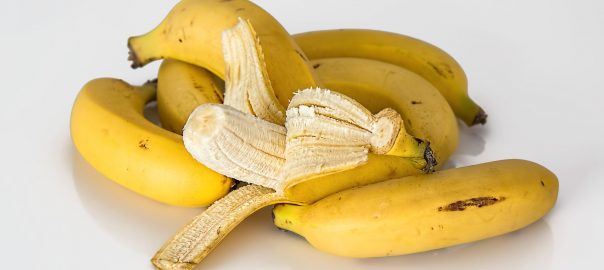Bananas are a comfort food for almost everyone. Creamy, tasty, and sweet, they are easy to eat. Everyone knows they are good for you (and unlike most other “good for you” foods this does not seem to bother anyone). Everyone also knows that bananas are a very good source of potassium. Most people, however, don't realize that there are a number of other healthy reasons to eat bananas.

Banana Bonanza
They are high in fiber, in the form of pectin, which is excellent for helping to ease constipation (because of the high potassium content bananas are also a good choice when it comes to replenishing the electrolytes lost due to diarrhea). Bananas also provide a high percentage of our daily amount of vitamin B6, which, according to Phyllis Balch, author of Prescription for Nutritional Healing, “is involved in more bodily functions than any almost any other single nutrient.” B6 is important for the immune, nervous and cardiac systems and is also important for circulatory health. Another helpful component of bananas is something called protease inhibitors; these can be helpful in stopping the bacteria that cause stomach ulcers.
Although we are used to seeing only two to three different varieties in the supermarket, there are believed to be around 500 varieties, including plantains. They come in all different colors and sizes. Bananas can be eaten when they are green, providing something called resistant starch which has a fiber-like effect on your system and also helps to promote “good” bacteria. The riper the bananas are when you consume them, the more antioxidants they provide, making them a great all-around fruit.
Most people do not like to eat very ripe bananas. When the fruit starts to get spotted on the outside they are frequently considered to be “over-ripe” although this is usually not the case. But if you won't eat them the issue becomes what to do with them. If they are too ripe for your palate and you are not in the mood to bake you can freeze them.
If you want to use bananas in smoothies you can peel them and then freeze them. Be sure to lay them flat while freezing to make it easier to remove from the container and throw into your blender.
If they are going to be used in baking you can simply freeze them peel and all. I would, however, suggest still bagging them together. Otherwise, you wind up with a rather large collection of frozen bananas in all corners of your freezer (ask me how I know this LOL). Freezing bananas in the peel is fabulous because when you are ready to use them you simply let them thaw on the counter. After they thaw you can snip the end off the banana and let it “goosh” into your mixing bowl where it will incorporate itself very nicely into the batter.
Today I happened to have 5 very ripe bananas and decided that it was a good day to bake. The following recipe is modified from one originally given to me by my friend Theresa. She got it from her grandmother, the family name for it was 1940's Banana Bread. The basic recipe is the same, I've merely changed the flour to gluten-free, the sugar to evaporated cane juice, and added pecans, chocolate chips, and a little vanilla to make a wonderfully tasty banana bread. Theresa bakes hers in loaf pans but I love making this in a bundt for that little extra touch.
4-5 ripe bananas
2 eggs
2 C. gluten-free flour (such as Pamela's)
1 C. evaporated cane juice crystals
2 t. baking soda
1 t. vanilla
1/2 C. chopped pecans
1/2 C. chocolate chips
preheat oven to 325 degrees F
grease a bundt pan and set aside
in a large mixing bowl mix bananas together
beat in eggs one at a time
add in flour, sugar and baking soda until well incorporated
add in vanilla, pecans and chocolate chips until well incorporated
pour batter into bundt pan
bake 1 hour or until cake pick inserted into batter comes out clean
remove cake from oven and let sit 10 minutes on cake rack
invert to release cake from bundt pan and let cool completely

Thanks. Maybe she does have an allergy and she didn’t understand that part.
There are some people who are allergic to latex who will indeed potentially have an allergic reaction to bananas. This reaction would also possibly be present for other foods such as kiwi, strawberry, chestnuts, avocados, passionfruit, plums, and tomatoes. It is not that these foods are high in latex itself but because the proteins in them are similar enough to latex to cause the allergic reaction.
Those most at risk for developing this allergy are health care professionals (high exposure to latex can potentially trigger an allergic reaction) and those who work in or around latex. If you develop the symptoms of latex allergy after exposure to latex or eating the foods listed above: dermatitis, wheezing, crusty lesions on the skin, anaphylaxis, itchy watery eyes, etc. it is best to discontinue eating the foods and see a health care professional for potential allergy testing.
I had someone tell me recently that it is NOT good to eat bananas. I still eat them, but her natural doctor told her they were high in latex or something that sounded like that. She was told it is because they are picked green and ripen in transit and in the stores rather than on the trees. Have you ever heard this?